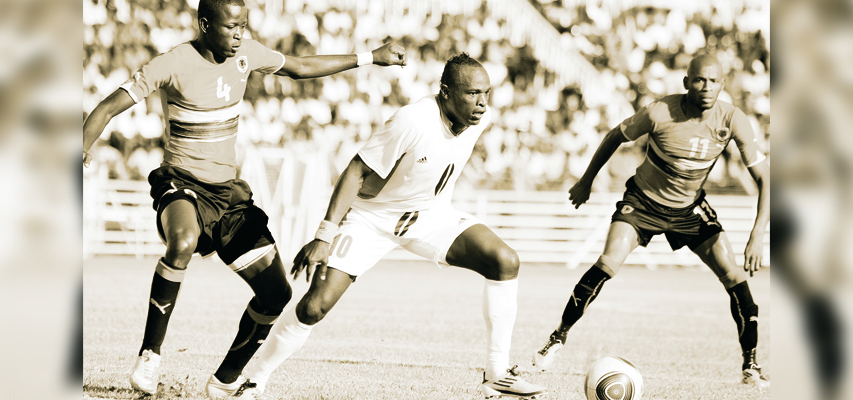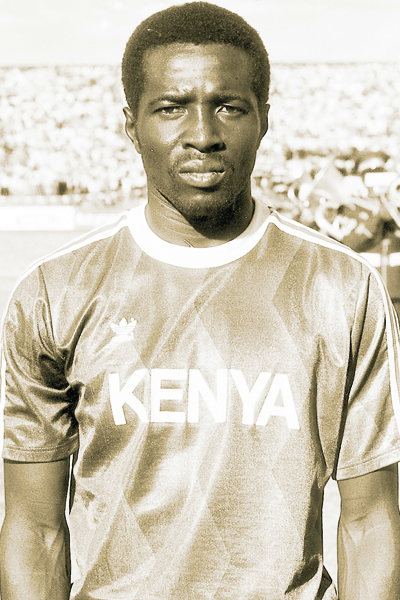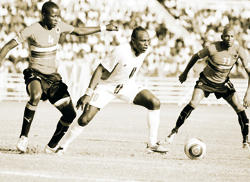
In 1969, without knowing that they were giving a cunning political animal ideas, bureaucrats at the Ministry of Cooperatives and Social Services announced that in the near future, football teams with tribal names would be excluded from FA of Kenya-run tournaments. Specifically, the teams targeted – and they were told as much – were Abaluhya, Gor Mahia and Ramogi.
Aish Jeneby, the feisty deputy Kenya Sports Officer who also doubled as up as an announcer during athletic meetings, released a press statement inviting an assorted array of stakeholders in football for their views on how they wanted to see the game run. At that time, well before Fifa asserted itself with an iron grip over its affiliates, football was being run by a Government appointed Caretaker Committee. This Committee was slated to give its recommendations on how the game should be run before handing over to an elected office by December of that year. Ministry officials decided to use that period to re-engineer the landscape of that game in the country. Acting for his bosses, Jeneby said:
“If any of the business firms, Government ministries and departments, Armed Forces and other interested parties wish to participate in FA of Kenya tournaments, they should write to the Kenya Sports Officer. Those in the provinces should communicate with our provincial Community Development Officers giving details of their interest and any suggestions which might help in the organisation of such tournaments in Kenya. As soon as we hear from the interested party, a meeting will be held to explain the future plans of such tournaments. If the firms made sure that their players turned out for them in tournaments, tribal sides would be weakened. Some firms have already stated their willingness to participate in our tournaments.”
Jeneby explained that the Government didn’t intend to ban the tribal teams but only to weaken them so that they could die a natural death. The plan was to encourage companies participating in FA tournaments to force their players to choose between their employer and their ethnic-based clubs. It was a no-brainer. Abaluhya were the first off the blocks in denouncing the Government move. They said their membership was open to anyone, as could be seen from their constitution.
Then they went on to curiously analyse which tribes were good at what. “The Kalenjin provide the track athletes, the Asian community the hockey and cricket players, and the Kikuyu the boxers,” said the Abaluhya statement, which dismissed the government plan as an exercise in futility because “even if they implement it, the majority of the players in the commercial teams will still be from the Luhya, Luo and Coastal communities.”
As far as Abaluhya were concerned, the problem with Kenya football was not tribalism but rather the FA’s incompetence, bad refereeing and Government disinterest.

Gor Mahia followed suit. Mahallon Danga, their unfaltering secretary, told the media: “It is said by the authorities concerned that tribalism can be eradicated by giving commercial sides more of a chance in big time soccer. This is not true. We feel that the advent of commercial sides in major tournaments will lead to the deterioration of Kenya soccer standards. Tribal sides like Abaluhya, Ramogi and Gor Mahia have been responsible for the rise of soccer standards in Kenya and abolishing them could prove disastrous to the country.”
Almost every club with an ethnic base – or a tribal sounding name – joined in the condemnation chorus. The Caretaker Committee subsequently convened a conference in Nairobi attended a cross-section of stakeholders, including ethnic- based and commercial clubs, representatives from government departments and the armed forces. Jonathan Njenga, its chairman, told the assembled delegates: “The decision to invite commercial sides, Government departments and the armed forces to compete in FA of Kenya tournaments was not meant to stamp out tribalism but to inject more interest in the game across the country. At present, interest in soccer in Kenya is dying mainly because a few clubs monopolise matters in all tournaments. If players were spread out into commercial and other sides, there would be more of a balance, and hence more interest.”
He was met with a chorus by the naysayers. Many told him tribalism would only change in form, but not in substance. The commercial sides could proceed to be dominated by players from one ethnic community despite the company’s neutral-sounding name. Others wondered what exactly was wrong with tribalism.
Still others dismissed commercial firms as being solely motivated by profits and not the improvement of the standards of the game. And then there were those who asked what the point of focusing on Nairobi-based clubs was when all over the country existed ethnic based clubs.
After this, the Government quietly engaged the reverse gear and nothing more of the plan was heard of the plan. Significantly, it must be pointed out that this was a move, whatever its merits, by Ministry bureaucrats with no political agenda of any kind. It was their idea of raising the standards of the game as required by their mandate.
But one man whose every breathe was politics must have been quietly impressed. And in his plans to rule Kenya, he filed this scheme securely at the back of his mind. Vic-President Daniel arap Moi succeeded Mzee Jomo Kenyatta as President of Kenya in 1978 against a backdrop of huge ethnic balkanization of the country. The Gikuyu Embu Meru Association, or Gema for short, was practically the ruling party under the aging president. Its officials had no time for him and many were the humiliations and indignities he suffered in their hands.
Most importantly, they openly attempted to bar him from succeeding Kenyatta by initiating a change-the constitution scheme that sought to remove the legal clause that allowed the vice-president to automatically ascend to the presidency for a period of 90 days pending elections in the event of the president’s death or incapacitation. He survived by the skin of his teeth, thanks to an Attorney General who had Mzee Kenyatta’s ear but who it turned was running a scheme of his own.
Moi had barely warmed the presidential chair than he moved to decapitate the heads of those who had sought to check his political career. In 1980, he convened a leaders’ conference at the Kenya Institute of Administration. Nobody remembers anything that came out of that conference other than a single decree: that all tribal associations disband themselves and that associations with tribal names change them to reflect “a national outlook.”
As political organizations like Gema and Luo Union fell like dominoes, the Kenya National Sports Council announced that the directive applied to sports associations as well.
All clubs with ethnic names, therefore, were to change them to reflect the new order. Goan Institute became Nairobi Institute. Sikh Union became Simba Union. Maragoli FC became Imara FC. Ramogi FC became Lake Warriors. Luo United FC became Reunion FC. And, in November 1980, with monumental suffering and immense reluctance, Abaluhya FC became All Footballers Cooperative Leopards Sports Club – or AFC Leopards for short, as it is still known today. To many faithful, something akin to death had just happened and tears flowed. It was a time of overpowering emotions.
But those were the days of an all-seeing and all-hearing Special Branch of the police which made people with a dissenting opinion to disappear. Thus, through their sorrows, club officials praised the President’s immense wisdom and pledged their total loyalty to him even as they let go of their blood identities.
But Gor Mahia, riding high as national and East and Central Africa Club Cup champions, said theirs was not a tribal name. They said it was the name of a person and they should be allowed to keep it. In December, 1980, to widespread jubilation by the K’Ogalo faithful, Jeremiah Nyagah, then the Minister for Culture and Social Services, agreed with them and said Gor Mahia should keep its name. Speaking at a season ending function at the Nairobi City Stadium, Nyagah said there was nothing wrong with a team being named after a person. However, it should not discriminate against anybody but continue to espouse the Nyayo philosophy values of peace, love and unity.
This was music to Green Army ears. But their travails were far from over. The KNSC, under chairman Charles Mukora, soon started piling pressure on the team to change its name as Nyagah went silent, probably unsure about whether there was a hidden hand behind Mukora’s intransigence.
In March 1981, Gor Mahia members convened a special general meeting at the Kaloleni Social Hall. Like their Abaluhya FC (AFC) counterparts before them and in the self-same venue, Gor Mahia faithful had come up with their own version of Gor. The name Gulf Olympic Rangers, or Gor for short, was floated to satisfy the Government. But as soon as he uttered the name, David Opar, the club chairman, fainted on the podium. He had started telling members of the immense frustrations the club was enduring “despite flying the country’s flag high” when he started weeping. Then he collapsed.
He was carried out of the hall for first aid. Meanwhile, chaos reigned in the hall. One member pointedly asked: “What is the difference between Bata FC, Brollo FC and Gor Mahia FC? Why should the other names be accepted and not that of Gor Mahia? All belong to people!”
As political organisations like Gema and Luo Union fell like dominoes, the Kenya National Sports Council announced that the directive applied to sports associations as well. All clubs with ethnic names, therefore, were to change them to reflect the new order

The meeting broke up without coming to a resolution. All this time, months into the controversy, President Moi kept his counsel. He was a man who commented on even the most mundane happenings in far flung hamlets, such as the doings of a witchdoctor named Kajiwe at the Coast and how he was disturbing the local women. But in this case, he let people stew in their recriminations.
Then, on March 11, returning from a visit to Nigeria, he made another of his classic saviour-from-on-high declarations: Gor Mahia were to keep their name! On landing at Jomo Kenyatta International Airport and after inspecting the customary guard of honour from a detachment of the defence forces, he declared that there was nothing tribal about the club’s name.
Chants of “Nyayo! Nyayo! Nyayo!” rent the air. The president had a habit of declaring a debate closed but in this case, he need not have bothered. The breathing out by the K’Ogalo faithful could have brought down mature trees. They feel over themselves to thank him.
Jasper Okello, the club’s secretary, said the president had “come to our rescue when all else seemed lost. We have always been Nyayo supporters and we assure the President and his government that Gor Mahia Football Club will strictly continue to uphold the spirit and philosophy of Nyayo at all times and at all costs.”
As on so many occasions in his long political career, President Moi was enjoying the last laugh. The campaign to change tribal names had little or nothing to do with nationalism but everything to breaking the backbone of his old nemeses, Gema. That was long accomplished and its leading lights, such as one Kihika Kimani who had described him as a passing cloud, were enduring the roughest patches of their lives, including going to jail. The Gor Mahia episode brought to heel a querulous constituency. It made them sing his tune, as he liked to say.
Compared with 1969 when civil servants were wracking their heads with what to do about the country’s football, this was nothing but politics. Yet, in the fullness of time, there has been a convergence. Since the 1980s directive, Kenya football has been dominated by commercial clubs and sometimes, one from the defence forces. But despite their longevity, they have not been able to build any substantial following.
Conversely, the two giants, AFC Leopards and Gor Mahia, even with when they have reached the lowest levels, including relegation from the national league, still dominate the terraces. Going by the number league titles won and distance travelled in the African continent, Gor Mahia is the more successful of the two. It is indeed Kenya’s most successful club.
Does this offer any insights on how we should name our clubs if we are to raise our passions and our standards? I think it does.
